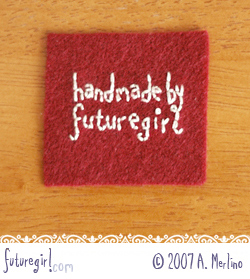
Here is a clever idea and tutorial on how to embroider on felt from Alice of futuregirl.com. She has clear step by step instructions for this procedure. When she started making handbags, she wanted cool labels and looked into ordering them, but she didn’t like the standard options, and custom labels were way too expensive. Her solution was to hand-embroider labels on felt. Futuregirl.com has several fun and useful tutorials and an extraordinary blog.
